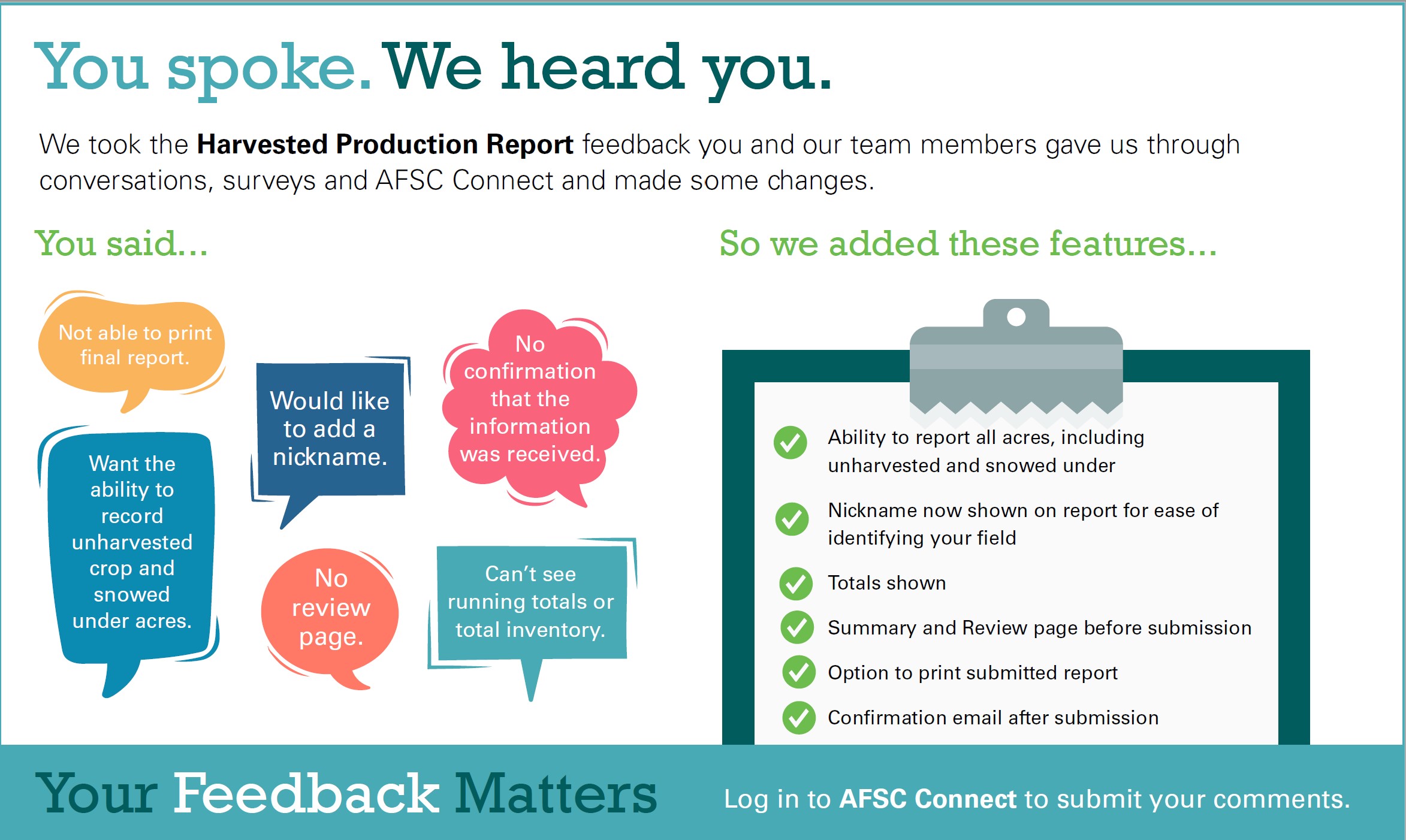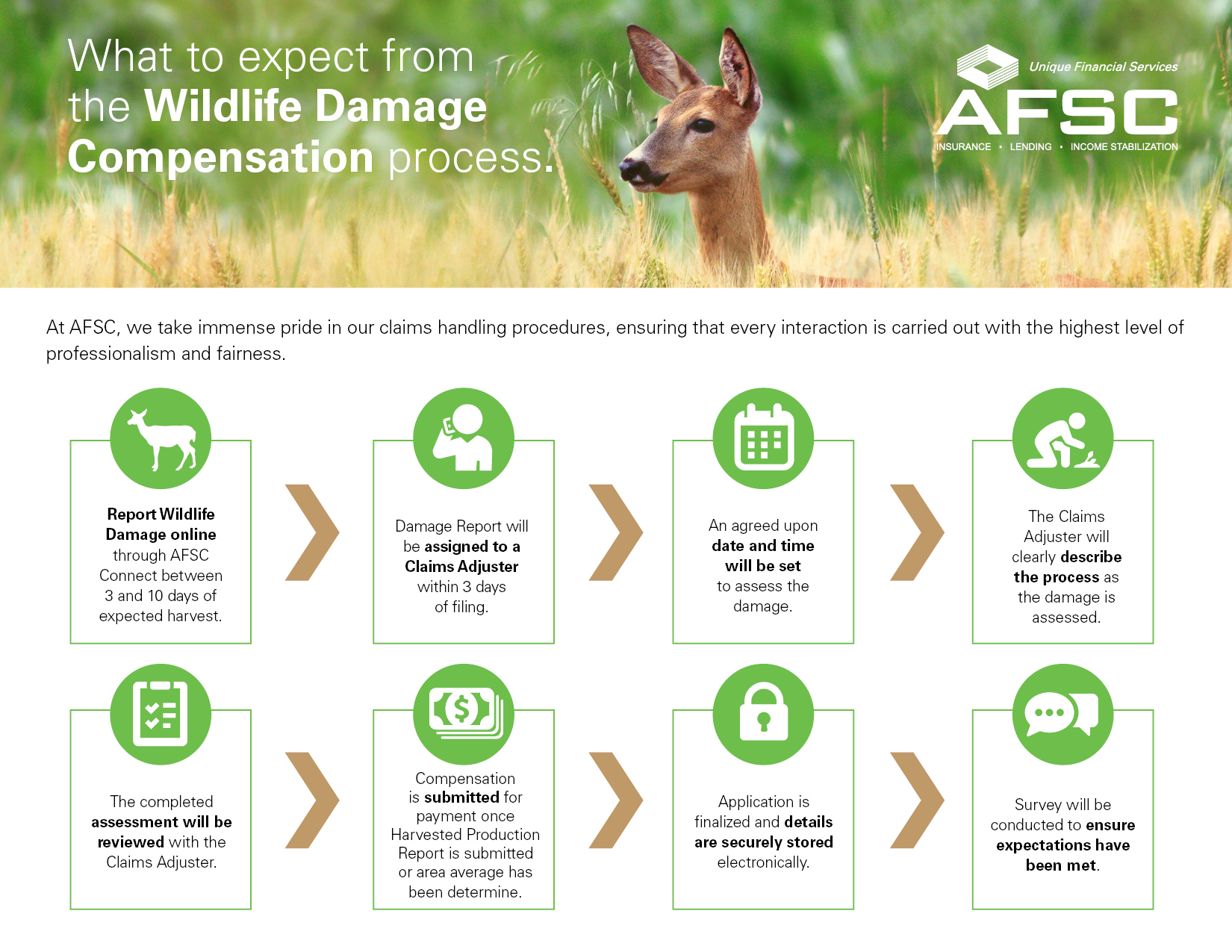Filing a Claim
Agriculture can be unpredictable and when the unexpected happens, crop insurance can help producers safeguard against loss. The different programs and features of crop insurance mean there are different claims processes depending on your coverage.
Area-Based Programs
Pasture (Moisture Deficiency Insurance), Moisture Deficiency Endorsement, Silage Greenfeed (Silage Greenfeed Barley Proxy and Silage Greenfeed Lack of Moisture), Corn Heat Units and New Crop Insurance Initiative
The claim trigger for area-based insurance, which includes Moisture Deficiency Endorsement, Pasture, Silage/Greenfeed, Corn Heat Units and New Crop Insurance Initiative, is the designated peril defined in the insuring agreement. Example – moisture or heat units at a weather station, satellite pasture readings or a proxy crop.
Claims trigger and are paid automatically when the current year’s designated peril data indicates a loss. Clients must notify their branch to defer an indemnity, prior to indemnities being issued.
Price-Protection Products
Variable Price Benefit
Claims for Variable Price Benefit (annual crops only) trigger after fall pricing is determined and are automatically paid.
Variable Price Benefit payments will only be deferred if the original claim was deferred.
Production-Based Programs
Reseeding Benefit
The Reseeding Benefit applies to annual insurance only and is available on most annual crops. It provides compensation on a spot-loss basis for acres damaged by designated perils prior to June 20 and is intended to partially compensate clients of the cost of reseeding the original crop.
Clients are required to notify AFSC of intent to reseed an insured crop. Clients need to contact their branch prior to reseeding and on or before June 20, and provide the following information:
- Legal land locations;
- Insured crop that is damaged;
- Crop intended to be reseeded;
- Number of acres to be reseeded; and
- The cause of loss.
Either an adjuster will inspect the acres to be reseeded or approval will be given by the branch staff to reseed. Acres that are not released by AFSC prior to reseeding are not eligible for this benefit.
Once reseeding is complete, the branch must be contacted. An adjuster will confirm the actual number of released acres prior to payment.
Unseeded Acreage Benefit
The Unseeded Acreage Benefit is included with annual insurance. It provides compensation on a spot-loss basis for acres unseeded due to excess moisture as of June 20.
Clients should contact a branch to file their Land Report and report any unseeded acres no later than June 20 and provide the following information:
- All legal land locations (reported separately by quarter section) that have unseeded acres;
- For each quarter section: Total number of cultivated acres;
– Number of dryland unseeded acres, and irrigated unseeded acres;
– Number of acres seeded;
– Number of acres intended for summerfallow;
– Number of acres in hay and pasture;
– Number of acres released for reseeding that could not be reseeded due to excessive moisture; and
– Whether or not fertilizer was applied, on a field-by-field basis.
AFSC will verify the total number of acres that qualify for an unseeded acreage claim and determine the level of payment by confirming field preparation expenditure.
Pre-harvest
If clients choose to put acres insured under production insurance – Hay, Export Timothy, Annual Crop, Processing Vegetables – to a use other than baling (perennial crops only) or combining (examples include pasture, plough under, silage, greenfeed, or any type of immeasurable state) an appraisal of the standing crop will be conducted. Clients are required to contact AFSC five days in advance of putting an insured crop to a use other than baling (perennial crops only) or combining to request an appraisal and release of acres.
AFSC will need to know:
- The legal land location;
- Crop type;
- The number of acres intended to be put to an alternate use;
- The reason for the alternate use;
- An estimate of the yield.
Depending on the estimate of yield, an adjuster may complete a field inspection to determine the yield appraisal before acres are released.
Acres put to an alternate use without authorization from AFSC, will be charged the premium, claims may be reduced or denied, and future coverage could be affected. Client must also advise AFSC upon completion of the alternate use. With AFSC approval, the client may have the option to leave standing inspection strips or swaths on acres being put to another use, to allow AFSC to conduct a preharvest appraisal. More information can be found on the Inspection Strips page.
Post Harvest
The Harvested Production Report (HPR) information provided by clients and the appraisal information provided from field inspections are used to determine whether there is a potential production loss. HPRs must be filed when harvest is complete and submitted online or to a branch no later than the deadline (October 15 for perennial insurance and November 15 for most annual insurance crops). HPRs which are submitted past the filing deadline will be subject to a late filing fee. Failure to file an HPR by December 31 will result in forfeiture of an indemnity and the application of a zero-yield estimate resulting in lower coverage for the future.
An AFSC adjuster may visit the farm to verify reported information and determine the cause of loss. Clients can request a 50 per cent advance or a preliminary payment for annual crops reported on their HPR, when there is a potential indemnity payment. Notification of an insurance claim and any required loss adjustment procedures are based on the information provided by clients on the HPR.
An adjuster is assigned to the claim and will make an appointment for a field inspection. The adjuster will:
- Verify and/or measure the number of acres insured;
- Identify acres harvested; and
- Determine the quantity and quality of the crop harvested by sampling storage facilities and reviewing production sales receipts.
Unharvested Acreage Benefit
The Unharvested Acreage Benefit applies to annual crops only.
Clients need to contact their branch on or before the deadline of November 15 to file Harvested Production Reports and to identify acres that remain unharvested (snowed under) due to weather. The Unharvested Acreage Benefit provides an advance payment for eligible acres on insured crops that remain unharvested after November 30 because of the onset of winter, when the client suffers a production loss. Acres will be considered eligible for the Unharvested Acreage Benefit when acres exceed 20 per cent of the insured acres for each eligible crop and production is less than coverage for that crop.
Hail and Fire Damage
Hail Endorsement or Straight Hail Insurance
For damage under either Hail Endorsement or Straight Hail Insurance, clients must contact AFSC within 14 calendar days of the hailstorm or fire. A minimum of 10 per cent damage is required to initiate a claim and there must be at least 10 per cent hail damage on each spot-loss area for that area to qualify for payment.
Clients are to check insured fields to identify the damaged areas prior to filing a hail claim and are expected to take the adjuster to damaged fields when the damage assessment is completed.
AFSC requires the following information when a report of hail damage is filed:
- The legal location and number of acres affected;
- The date of the storm;
- Estimate of the per cent of damage for each crop; and
- Notification if the crop will be put to another use.
Clients are required to accompany the adjuster during a claim inspection and to take the adjuster to the damaged areas of each field. Claim adjusters may wait to adjust a claim so that damage is more accurately identified. Claims may be deferred if crops are not sufficiently mature for accurate damage to be assessed. If the crop is damaged when mature enough to harvest, once authorized by AFSC, clients may leave standing inspection strips for adjusters to use to assess damage. More information on inspection strips is available on the Inspection Strip page.
Spot-Loss Fire Benefit
The Spot-Loss Fire Benefit applies to pasture insurance only.
Clients must notify AFSC within 14 days of the start of the fire on their land and provide any relevant documentation from the fire department. Clients need to complete the Fire Damage Claim Form.
Hail & Fire Damage Resources
Wildlife Damage Compensation Program
Producers should notify AFSC a minimum of three days prior to the intended harvest date so AFSC can arrange to have an adjuster perform an on farm inspection. A non-refundable appraisal fee of $25 per inspection type is required for each section of land or portion thereof on which damage has occurred.
In order to be compensated under the program, there must be at least 10 per cent wildlife damage and a minimum of $100 calculated loss per crop. Damaged crops cannot be cut until inspected, as wildlife claims cannot be adjusted from representative strips.
Producers should check their fields to identify the damaged areas prior to filing a claim. Producers are expected to take the adjuster to the damaged fields when AFSC completes the damage assessment.
Wildlife-excreta-contaminated crops – compensation is provided to producers who have incurred cleaning costs and/or market value loss for crops contaminated with wildlife excreta. Producers must not have sold, disposed of or cleaned the crop prior to initiating the claim; otherwise their request for inspection will be rejected.
Stacked hay and silage/haylage in pits and tubes – producers are responsible to notify Fish and Wildlife as soon as possible after first noticing wildlife damage and prior to reporting the Wildlife damage online through AFSC Connect. A provincial Fish and Wildlife (FW) Officer will visit the site and provide the producer with appropriate recommendations to prevent further damage prior to AFSC inspecting the damage.
Wildlife damage reported over the winter will not be finalized until all damage has ceased and the total damage can be determined. For AFSC insurance clients, the wildlife claim will be deducted from any insurance payments.
Field Inspections
AFSC recommends that the client accompany adjusters during field inspections to understand the assessment process. The adjuster will explain the procedures being used, request a client signature on the loss assessment documents, and will leave copies with the client.
If there is a disagreement with the initial loss adjustment, a second inspection by a senior adjuster may be requested.
Once the second inspection is completed and there is still disagreement, an appeal may be filed by following the procedure outlined in the AFSC Contract of Insurance. More information on the appeals process can also be found on the Appeals page.



